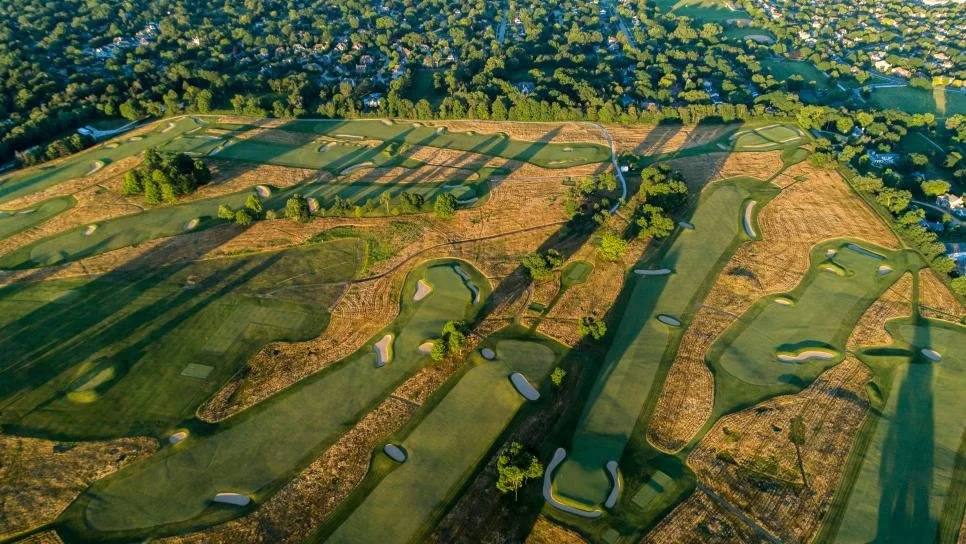The Grounds: Lesson 4: Charles Blair Macdonald - Walker Simas
Welcome back, GCA sickos! We're back with another edition of "The Grounds” - a series of newsletters presented in text, podcast, and YouTube formats.
As someone who first appreciated golf course architecture through a competitive lens, I’ve been increasingly into the historical “why’s” behind our favorite designs.
As with anything, there’s always more to learn. I have a basic understanding of most of the names in this series, however, this is my homework out in the open as I sift back through the evidence of what these architects created.
If you've missed our previous episodes, don't worry, we've got you covered. So far, we've explored the legacies of Old Tom Morris, James Braid, and Willie Park Jr., working chronologically to Ben Crenshaw. But hold onto your putters, because we've got a whole lineup of architects waiting in the wings, including today's feature, the illustrious Charles Blair Macdonald.
Historical Background:
Let's take a quick trip down memory lane to understand the world in which C.B. Macdonald made his mark.
It's the late 19th and early 20th centuries, a time of bustling activity in the United States. Cities are growing, industries are booming, and those making the profits are looking to sink their teeth into something meaningful. Golf, with its blend of leisure and challenge, starts gaining traction across the nation.
Here are some snapshots of what's happening:
The Industrial Revolution is in full swing, bringing with it rapid urbanization and economic growth.
Railroads crisscross the country, making travel easier and connecting people in distant cities.
The economy is booming, creating an ever-growing middle class with disposable income to spend.
Social clubs and organizations begin to spring up - the people want recreation.
Investors and developers see the potential in building golf courses as a way to attract residents and boost property values.
Starting with the End in Mind:
Photo: Jeff Marsh for USGA (Lido)- Sand Valley, WI
Many of you already have a picture in mind when thinking about Macdonald’s designs or recent interpretations of them. I’m thinking about Sand Valley’s Lido - a Doak, Schneider, et. al. as an example. Maybe for you it’s Chicago or National Golf Links (which we will get into later) – maybe there’s no picture at all. In that spirit, let’s paint you a picture of C.B’s inspiration, methods, and principles.
Inspiration:
Studied at St. Andrews University in Scotland in 1872.
Developed his passion for golf under the guidance of Old Tom Morris.
Brought Scottish golfing principles to American land.
Methods:
Leveraged financial expertise to gather funding, support, and/or interest.
Executed projects he found worthwhile for no fee whatsoever.
Partnered with Seth Raynor, enhancing engineering and strategic planning in designs.
Principles:
Imported 21 'template holes' from Scottish courses to America.
These are concepts we still use and think highly of today- interpreted by many.
Meticulously crafted for strategic options that functioned with the natural landscape.
Challenge elite players while remaining accessible to all skill levels.
Charlie’s Resume:
These (above) are just some highlights of C.B.’s career from a macro scale. When exploring his work in America as opposed to other named architects before or after him, what immediately sticks out to me is his metaphorical batting average of great courses. Tom Doak has built 40 golf courses, and 5 of them are in the top 100. Take a look at this resume—
1895: Chicago Golf Club
Photo: Andy Johnson (Fried Egg)
1896: Onwentsia Club
Photo: Scott Vincent
1897: Exmoor CC (first 9 holes)
Photo: Patrick Koenig
1909: National Golf Links of America
Photo: Patrick Koenig
1911: Piping Rock Club
Photo: Patrick Koenig
1914: St. Louis CC, Sleepy Hollow CC, Lido GC (original), The Greenbrier: Old White
St. Louis CC - Photo: Andy Johnson (Fried Egg)
Photo: Jon Cavalier (Links Gems)
The original Long Island Lido
1916: North Shore CC, Shinnecock Hills GC (original)
North Shore CC: Photo: Golf Digest
Shinnecock Hills: Photo: Dom Furore
1921: Mid Ocean Club
Mid Ocean Club: Photo: Sean Ogle (Breaking Eighty)
1922: Gibson Island Club
Photo: Jon Cavalier (Links Gems)
1924: Deepdale GC (original)
Photo: Evan Schiller
1925: The Creek Club
Photo: Evan Schiller
1926: Yale GC
1927: Palm Beach Winter GC (original)
Village of North Palm Beach
ALL certified bangers. ALL well taken care of today (minus Palm Beach Winter Club, which looked incredible).
Case Study #1: Chicago Golf Club:
Photo: Andy Johnson (Fried Egg)
Founded in 1892, CGC holds the distinction of being the first 18-hole golf course in the United States. Macdonald's influence there extended beyond the design. Not only was the inaugural U.S. Amateur Championship held at Chicago Golf, but Charles Blair won the damn thing.
Today, it’s one of the most studyable American designs, though it sits on a different site than where C.B. originally built, Wheaton and its subsequent redesign under Seth Raynor (with the help of Harry Colt) is further proof of C.B’s legacy.
Case Study #2: National Golf Links of America:
Photo: Patrick Koenig
Founded in 1908, NGLA stands as a testament to Macdonald's vision of bringing the best qualities of British golf to American soil. Situated on Peconic Bay in Southampton, New York, the course is a masterpiece of golf architecture, meticulously crafted to replicate the challenges and charm of the famed links courses of Scotland and England. Macdonald was so caught up about getting it right, he apparently took quite a few trips back to Scotland for further R&D. Macdonald's collaboration with civil engineer Seth Raynor further enhanced the course's design, setting the stage for a golfing haven that continues to inspire architects and players alike. It remains a pinnacle of American golf- another proof that C.B.’s work was built to stand the test of time.
Template Holes: What are they?
Drawing: Benjamin Warren (Artisan Golf)
Template holes are like blueprints for designing golf courses, but they're not a one-size-fits-all solution. Instead, they're interpretations of the best examples of strategy from Scottish golf courses. Think of them as guidelines that architects use to create interesting and challenging holes, each representing a different type of hole with unique features. These features, like bunkers or tricky greens, add excitement to the game and provide golfers with a variety of carefully crafted challenges to navigate.
When doing a deeper dive on templates, I saw Benjamin Warren’s article, and decided I couldn’t improve upon it. You can read about them here.
An Opinionated Ego that Paved the Road to the USGA:
Part of building golf courses is the necessity of a team - often more than one opinionated leader is needed to get the job done. Macdonald was the cilantro of GCA - his opinion was a necessary addition to one, and tasted like soap to another. Let’s dive deeper into this, because it’s brought up enough to be relevant.
Maybe his ego developed earlier, but as far as I can tell, once he became instrumental in establishing golf in Chicago, that was when his true character showed.
His fiery temperament and uncompromising stance on matters such as tournament conduct and rule modifications often led to clashes with tournament committees and fellow golfers. Macdonald's infamous "hissy fits" following his losses in early national championships prompted a call for order and governance within the American golfing community. This culminated in the formation of the USGA, with core clubs uniting to create a governing body that could maintain order and uphold the integrity of the sport. Macdonald's influence, while divisive, undeniably shaped the trajectory of golf in America
Macdonald's ego often overshadowed his achievements. As we know, it’s difficult to make judgment on something you didn’t see first hand. Despite this, C.B. may have been right, but he was accounted by many to be some version of an asshole. Regardless, we have Charlie to thank for creating the USGA.
Conclusion
Wrapping things up, we've covered a lot of ground on CBM. We covered his inspirations, methods, and signature principles. From the iconic Chicago Golf Club to National Golf Links of America, Macdonald's legacy is undeniable. Yet, his strong opinions often sparked debates within the golfing community, adding a dash of controversy to his illustrious career. But fear not, our exploration doesn't end here! Stay tuned for our next feature, where we'll shine the spotlight on Herbert Leeds. And remember, there's more engaging content waiting for you on our podcast and YouTube channels in the coming days, so be sure to check them out.





















